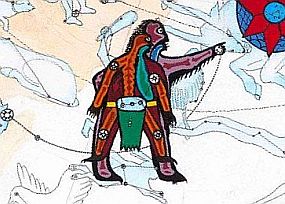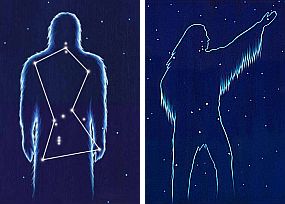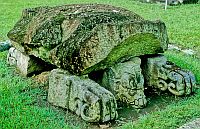Wikipedia
R.H. Allen:
Star Names
Ian Ridpath:
Star Tales
Universe Guide
Sea and Sky:
Constellations
IAU
Map
NASA:
Constellations
|
Wikipedia |
R.H. Allen: Star Names |
Ian Ridpath: Star Tales |
Universe Guide |
Sea and Sky: Constellations |
IAU Map |
NASA: Constellations |


|
|
Star LoreOrionPart 5 - The Americas |
|


 Xiuhtecuhtli
Xiuhtecuhtli |
Orion is one of the most prominent and most recognizable constellations in our winter
sky. Located on the celestial equator, the constellation is visible throughout the world. The constellation is named after the hunter Orion in Greek mythology. In addition, there are other myth about Orion in many parts of the world. |


|
|
Aztecs
The Aztecs called the stars of Orion’s Belt and
Orion’s Sword the Fire Drill.
|
 Xiuhtecuhtli,
Xiuhtecuhtli,God of Fire Source: Mexicolore |


|
|
Bororo
The Bororo people in what is now the Brazilian state of Mato Grosso had a massive constellation
representing a caiman, showcasing the prominence of caimans in daily Amazonian life.
|
 Caiman of the Bororo
Caiman of the BororoSource: fairbanksmuseum.org |


|
|
Chinook
To the Chinook people, the stars forming Orion's Belt and
Sword are two canoes vying to be the first to catch a salmon in the Big River,
which is the Milky Way. The little canoe is winning the race and is closing in on the fish,
which is Sirius (Alpha CMa), the bright star in the middle of the river.
|


|
|
Cree
In Cree mythology, Orion is generally seen as Wisakaychak, the benevolent culture hero of
the Cree tribe, among other deeds credited with the creation of the Sun and the
Moon.
|

 Wisakaychak on the Cree star map
Wisakaychak on the Cree star map© Native Skywatchers |
 Mistapew & Wisakaychak
Mistapew & WisakaychakSources: Wilfred Buck; Atchakosuk |
 Wisakaychak creates the Sun and the Moon
Wisakaychak creates the Sun and the MoonSource: Lance Cardinal |


|
|
Inuit
The Inuit in northern Canada call Orion's Belt "The
Runners." Alnitak is seen as a polar bear and Alnilam
and Mintaka are dogs.
|


|
|
Lakota
To the Lakota, Orion's Belt is the spine of a bison, called Tayamnicankhu.
The surrounding rectangle of the constellation forms the ribs.
|
 Lakota Buffalo Drum
Lakota Buffalo DrumSource: horsekeeping.com |

|
|
Another Lakota story symbolizes the harmony between the gods and the people with the help of the younger generation.
 In that story, the bottom half of Orion is called Napé, representing the hand of a great Lakota chief. Orion's Belt forms the Chief's wrist, the thumb is formed by Orion's Sword. Rigel is the tip of the index finger, and Cursa (β Eridani) is the tip of the little finger.  The tale tells us how the gods wanted to punish the Lakota chief for his selfishness and made the Thunder People rip out his arm. To help her father, the chief's daughter offered to marry whomever would recover her father's arm. One man made a long and perilous journey through the sky and the Earth. Fallen Star, a young warrior born of a mortal mother and a celestial father, returned the lost arm to the chief and married his beautiful daughter.  Source: Mr. Scienceut |
 The Chief's hand
The Chief's handSource: Mr. Science |


|
|
Maya
Maya constellations are widely disputed, but Ysgrifen and
Milbrath
see evidence that the Maya may have seen a turtle in the constellation Orion.
|
 Cosmic Turtle Altar in Copan ruinas
Cosmic Turtle Altar in Copan ruinas© Peter W. Wendelken |


|
|
Navajo
The Navajo add another facet to the world-wide picture of Orion as the big hunter. The costellation
is depicted as Átsé Ets’óz, First Slender One - a young man in the prime of life. He carries a bow and arrow and is a warrior protecting his
people. Like Dilyéhé, this constellation is related to planting and is seen every season except for part of the summer.
Legends of Orion and Scorpius representing antagonistic characters that can never be seen together in the sky are also part of Greek and Chinese mythology. |

|


|
|
Ojibwe
On the Ojibwe Star Map, Aldebaran (α Tau),
together with Procyon (α CMi) and the stars of Orion,
are called Biboonkeonini, the Winter Maker, as their presence in the
night sky heralds winter.
Ojibwe artist Carl Gawboy tells a story of parents making bows and arrows
for their young children to come out into the late winter night to shoot at Wintermaker, whose sash is the belt of today’s constellation called Orion.
For the Ojibwe, the constellations of Biboonikeonini, Mishi Bizhiw, Nanaboujou and Mooz heralded the arrival of winter, spring and summer and fall.
|
 Biboonkeonini
Biboonkeonini© Native Skywatchers
|


|
|
Seri
The Seri people of northwestern Mexico call the three stars of Orion's Belt
Hapj, a name denoting a hunter. The three stars are Haamoja, the pronghorn, Hap, the mule deer and Mojet, the
bighorn sheep.
|
 Orion
Orion© Ashleigh Dyan Bayer |


|
|
Yokut
The Tachi Yokuts in what is now California told a tale of a selfish wolf who didn't provide food for his wife crane and his two sons. Eventually Crane
and her sons ran away. Wolf followed them and tried to shoot Crane with his arrow but in the end, Crane stabbed wolf to death with her long sharp bill
and flew away into the sky. Her sons followed her and the three became the stars of Orion's Belt.
|


 |
Back to Africa and Australia | Forward to Orion Myth Start Page |
 |


|
Back to Star Lore |
Back to Mythology |

Back to Orion Myth |
Back to Space Page |
Back to English |
 Back to Start Page |